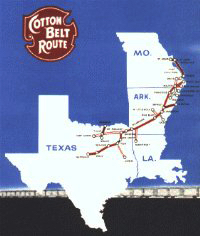Little River Valley and Arkansas Railroad
James Paramore’s first acquisition was the Little River Valley and Arkansas Railroad Company by Paramore, and he became president of that company on May 13, 1881. This small railroad is the oldest incorporated company of the many that have been consolidated to form the present system. It started its existence as the New Madrid and West Prairie Road Company, by authority of a special act of the General Assembly of the State of Missouri, on February 22, 1855, for the purpose of constructing a wagon toll road.
Apparently, the road remained incomplete twenty years later, as on October 11, 1875, the County Court of New Madrid County, Missouri, in an order reciting that certain stockholders of the New Madrid and West Prairie Road Company had conveyed their stock to George B. Clark and Oscar Kochtitzky, ordered that the stock held by the county also be conveyed to them in order to secure the completion of the road.

On the following day, October 12, 1875, the court gave its approval for this company to construct the road, and, for the necessary funds, to use the proceeds from the sale of land that they secured in the original chatter. As it was found possible to raise money for a railroad, they, on September 7, 1876, organized the Little River Valley and Arkansas franchises of the New Madrid and West Prairie Road Company, consisting of its right-of-way, wagon roadbed, and appurtenances, extending from New Madrid to Malden, Missouri, a distance of approximately twenty-seven miles, together with 70,000 acres of swamp timber land in New Madrid County.
This three-foot narrow-gauge was opened for traffic in January, 1878. The road ran through what is known as the "Nigger Wool Swamp" area of Southeast Missouri. The capital stock was authorized at $270,000. Throughout the entire life of the road, its rolling stock consisted of two locomotives, two passenger cars, and thirty freight cars, which were enough to handle the meager traffic it carried.
The only available statistics on operations show that in 1879 there were 3,744 passengers carried and 8,977 tons of freight handled. The following year the road's total earnings were reported to have reached $21,868. A. M. Stead was President and Chairman of the Board of Directors until replaced by James W. Paramore.
